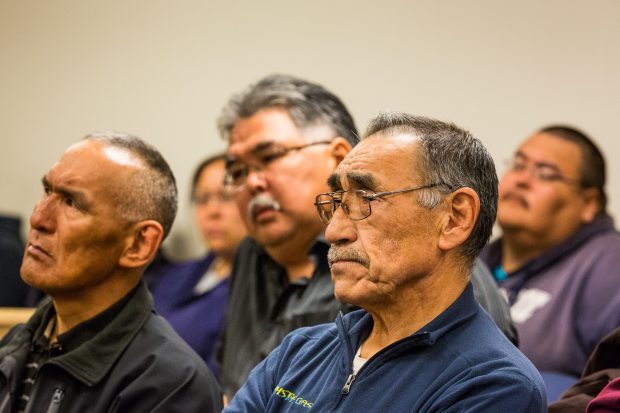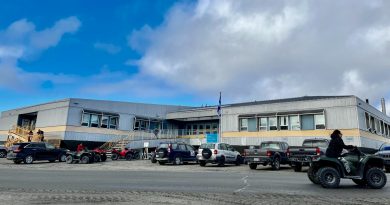COMMENTARY – Fuzzy math of Alaska subsistence: Too many people, not enough fish, game

(Loren Holmes / Alaska Dispatch)
Alaska’s long, difficult, subsistence struggle was back before the Alaska Boards of Fish and Game last week with the many competing interests trying to paint the kaleidoscope black and white.
Urban Alaska hunters and anglers often seem unable to grasp that subsistence is a touchstone for Alaska Natives, especially older Natives, watching the younger generation teased into the American melting pot by the attractions of TV and the Internet.
Rural Alaskans, meanwhile, particularly rural Natives, seem unwilling to recognize that the subsistence priority afforded rural communities leaves some urban Alaskans feeling like second-class citizens. People who grew up hunting and fishing can struggle to hang onto their last contact with hunter-gatherer culture. They suffer at the idea of being denied hunting and fishing opportunities so others can be guaranteed such opportunities.
And, of course, no one wants to face the reality that subsistence itself is dying beneath a population boom and the changing views of an evolving society. A thousand years ago, nobody thought about the idea of creating parks where animals would live in their natural state, uninfluenced by the activities of humans.
Now there is a whole subset of people who think that is the way all animals should live. And this is but a small part of the problem facing Alaska, where things might be worse but for the outmigration of people sadly leaving their villages never to return — or seldom to return — because of the lack of economic opportunities.
Despite this, some villages have grown, like some of the regional hubs in rural Alaska, and they are now taxing wild systems. It is nice to believe in the idea of living off the land in Alaska, but the land won’t support many people.
Imagine 3.8 million moose
Winters are long, summers short. The result is a relatively unproductive ecosystem. There are an estimated 175,000 to 200,000 moose in all of Alaska. There are an estimated 76,000 in Maine, a state about 5 percent the size of Alaska.
If far-north Alaska could grow moose as efficiently as mid-continent Maine, there would be about 3.8 million of the big ungulates here. Many Alaskans wish it was so. They’d like a moose behind every spruce, but it will never happen.
Alaska is not a rich land; it is a harsh land. Before the white invasion, only about 75,000 people survived here on what the land would yield. Today, the Alaska population is approaching 10 times that number. The Native population alone is double what it was before white contact. The idea people are going to go back to living off the land come an apocalyptic collapse of the U.S. economy is a myth.
Of fish, fortunately, there are more. They do not need to survive long here before going to sea in the comparatively warm waters of the North Pacific, which is far more ecologically productive than any Alaska uplands. But even with fish there are problems.
Enter the subsistence community of Bethel on the banks of the Kuskokwim River 400 miles west of Anchorage.
King salmon chaos
There was chaos in Bethel a year ago. The chinook salmon — the big kings — did not come back in the numbers forecast in the summer of 2012. The Alaska Department of Fish and Game closed the season to save spawning fish to ensure future runs.
Fishermen revolted. They went fishing anyway. Many were arrested. There were high-profile trials this spring at which they argued they had a “religious right” to fish. A state judge ruled that, yes, indeed, they might believe that and they might even have a religious right to some sort of ceremonial fishery. But at the end of the day, the survival of the fish trumps anyone’s right to fish.
Everyone was convicted, but in the strange politics of Alaska it had been earlier decided that maybe the scientists who manage the fishery had been too conservative in their protection of the salmon, and maybe more could safely be caught then previously thought.
So spawning goals were lowered and everyone was allowed to fish this summer. The result was a disaster that’s still being tabulated. The Kuskokwim king run was badly overfished. The consequences of that will not be known for years, but what biologists know full well now is that if this sort of fishing goes on year after year, the king returns of Alaska’s second-largest river will be decimated.
Partially out of this came a proposal to the state board of fish to declare Bethel a “non-subsistence area.” The designation would have given fish managers a lot more flexibility. Instead of allowing everyone along the Kusko to fish every subsistence opening, they could have created what is called a “personal-use fishery” for Bethel, and used it to limit how many fish residents of that community of more than 6,000 could bring home.
There is a personal-use fishery on the Kenai River 120 miles south of Anchorage. It opens on July 10 and runs through the end of that month. The participants are limited to dipnets, and they can only fish from 6.am. to 11 p.m. each day. They are restricted in the number of fish they can catch, and yet the fishery is hugely popular.
Tens of thousands of Alaskans flock to the Kenai from the cities of Homer and Soldotna on the Kenai Peninsula, and from Anchorage, the Mat-Su Valley and even Fairbanks, some 500 road miles to the north. Many of them catch a winter’s supply of salmon.
None of them enjoy a priority. They fight constantly with commercial fishermen, who catch the bulk of Cook Inlet salmon, over who should get the fish. But the fishery functions, and it allows the state to control harvests.
On the Kuskokwim, there is no longer a commercial fishery for king salmon. It fell victim to the subsistence priority long ago. Now, there is only a subsistence fishery with too few fish to allow everyone to subsist on it.
But the suggestion the residents of Bethel be removed from those allowed to subsist on the fishery brought cries of anguish. The city council objected. Community leaders objected. Regional leaders objected. Almost everyone objected.
“Bethel is growing, and it’s a big village, and neighboring villages are not happy with that, too,” James Charles told the boards. “Our group is always not happy with some things like that.”
Tuntutuliak, Kalskag and Bethel
Charles is from the downriver village of Tuntutuliak, population 408. He is an older Yup’ik Eskimo, who chairs the village’s advisory committee on fish and wildlife.
“We still meet in Yup’ik,” he said. “Not many of us speak English.”
The residents of Tuntutuliak recognize the problems in competing with Bethel, a community 15 times larger with an economy that allows people to hold jobs, enabling them to buy better boats and fishing gear. But, he added, a lot of those people are family.
One cannot deny the subsistence priority to family.
Seventy-eight-year-old Robert Aloysius from the upriver village of Kalskag said much the same. He chairs an advisory committee representing four small villages upriver from Bethel.
The villages, he testified, are “unanimously opposed” to the idea of denying Bethel the subsistence priority. Elders sometimes move to Bethel to live because it is easier to find housing, he said. Others might spend months there to be near the hospital or near loved ones at the hospital. They need subsistence, too.
“Without the land we have nothing,” he said. “We depend on the land…That is our Fred Meyer, our Walmart.”
Aloysius is among those afraid of losing the connection to the land, fearful of the younger generation fading away.
“I was raised by two grandmas. I was taught to love and honor all aspects of creation. That education has been pretty much put aside because, unfortunately, the federal government came into our lives,” he said.
The federal government promised no one needed to worry because “we’ll take care of everything for you. Today we are suffering for it. … It’s unfortunate that the introduction of money created chaos in how we interact with nature.”
Aloysius now believes the salvation for his people is to go back to the old ways, to “stop looking at everything as potential income…Many of our people are caught up in that same situation.”
This is a belief shared by more than a few in rural Alaska. It overlooks realities no one wants to talk about. There are in some cases — as with king salmon and moose — not nearly enough fish or game to support the people who want them now.
And there is the need for cash in a world more dependent on it.
If all means of monetizing the more plentiful resources — such as red and chum salmon — are eliminated, where will cash come from?
The boards wrestled with that, too. There were proposals to change the rules on the trade and barter of subsistence-caught fish and game to try to allow people access to more money.
Testimony inevitably strayed into class warfare.
“It’s tough living in the village,” said Rick Rowland, the natural resources director for the Sun’aq Tribe of Kodiak. “Gas is expensive. Bullets are expensive.
“If we’re going to cap the people in villages (on case deals)…then we need to cap most of those commercial users who are living outside of the state, and those big game guides who are charging $10,000, $12,000 for hunts.”
Commercial fishing, he observed, is a $3 billion a year business that catches 98 percent of the fish harvested in Alaska. Why should it continue when people need fish to eat?
Complicated situation
What he did not say is that most of those commercially caught fish are species Alaskans generally do not want — such as pollock or pink salmon. Both are available in such vast numbers that subsistence or personal-use fishermen can already get all they want.
The battles develop over far-less-plentiful species or in places like Bethel, where the surrounding area provides less than in ecologically richer areas.
The situation here is complicated, and there’s no sign it will get less complicated soon. If the Kuskokwim kings are any example, it might be working its way toward the solution that resolved the subsistence issue Outside.
Fish and wildlife populations in the Lower 48 were fished and hunted to populations so low that it became hard for anyone to subsist on them anymore. Subsistence in the Lower 48 faded away as the conservation movement began to emerge in the interest of saving fish and wildlife near the start of the 20th Century.
Conservation movement: winners and losers
The conservation movement is now viewed by many as a great American achievement. But as historian Christopher Wells has observed, it wasn’t all so wonderful.
“The conservation movement also placed unequal and sometimes severe burdens on certain groups,” writes the assistant professor at Macalester College. “Conservation laws that criminalized some uses of natural resources, for example, imposed harsh limits on socially and economically marginal segments of the population. Cutting down trees on public land to build log cabins became timber theft.’ Burning forests to clear land for agriculture or underbrush to attract game became ‘arson.’ Hunting game for meat, except under carefully regulated conditions, became ‘poaching.’ Not surprisingly, poor rural Americans often objected to conservation laws for cutting off access to natural resources that had long been a central (and celebrated) component of frontier life. According to these critics, conservation laws seemed designed to take from poor rural folks in order to benefit wealthy urban sightseers and sport hunters.”
There are poor people in Alaska today who view conservation in almost the same way. It is going to make it difficult to find an easy way into the future. What is playing out in Alaska looks a lot like what played out long ago in the rest of America.
The state boards of fish and game wrestled with it, and then they did what most knowledgeable observers expected them to do: Nothing.
Bethel remains a subsistence community, as does the busy port of Kodiak, which was also suggested for removal. How eventually the harvests of fish and game will work themselves out in both areas remains to be seen. Kodiak is an island surrounded by rich marine life. It should, theoretically, be able to support subsistence activities for a long time yet.
Bethel is a decidedly different case. Bethel is a place where a population that was declining at the end of the 1990s is again growing. It is up 16.5 percent since the year 2000. The community is twice the size it was in the 1970s. There are now more people living in Bethel proper than were living in the entire Bethel Census Area — a 46,000 square-mile-swath of Western Alaska — in 1960.
Demographics alone would indicate the issue of subsistence in Bethel is not going away any time soon, and it presents difficult questions with no easy answers.
Contact Craig Medred at craig(at)alaskadispatch.com




Perhaps a solution could be to give more control over the fishery, and over hunting too, to the local residents. There is a native corporation which I understand is similar to a Canadian First Nation. Perhaps it could administer the subsistence takes.When we give people responsibility, people tend to live up to it. Currently, many of the rural residents are not empowered so feel less responsible. Don’t forget that these people devised sustainable ways of living over thousands of years prior to contact with European culture.